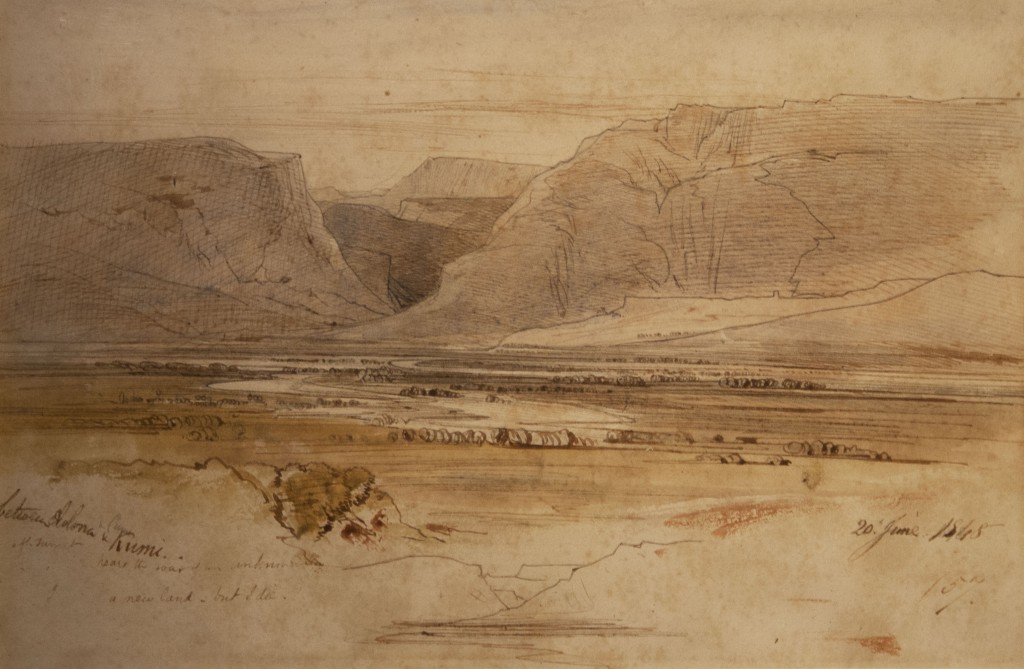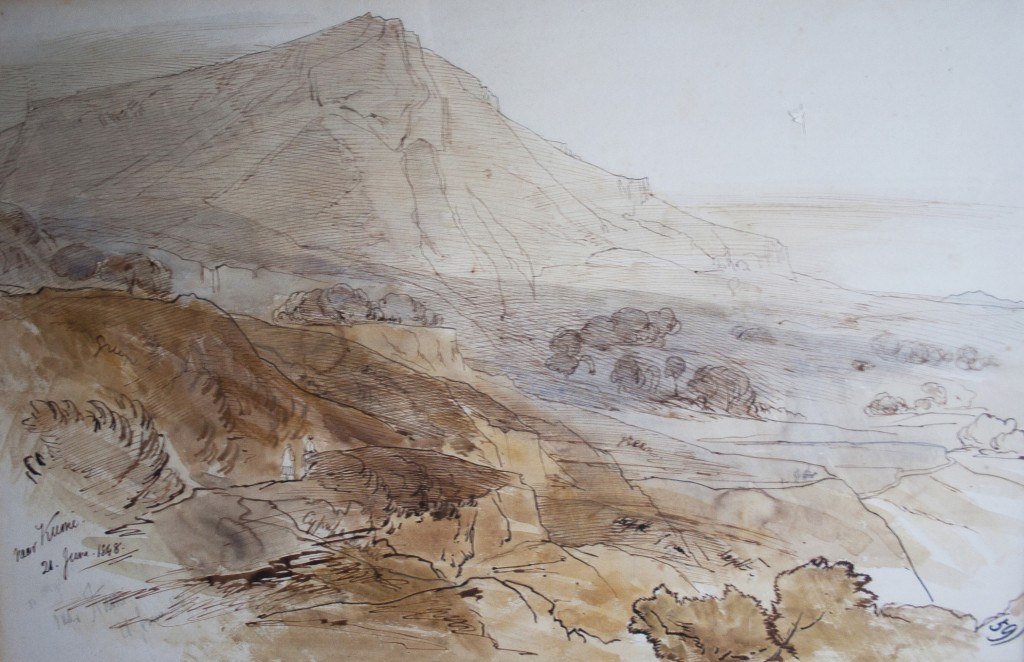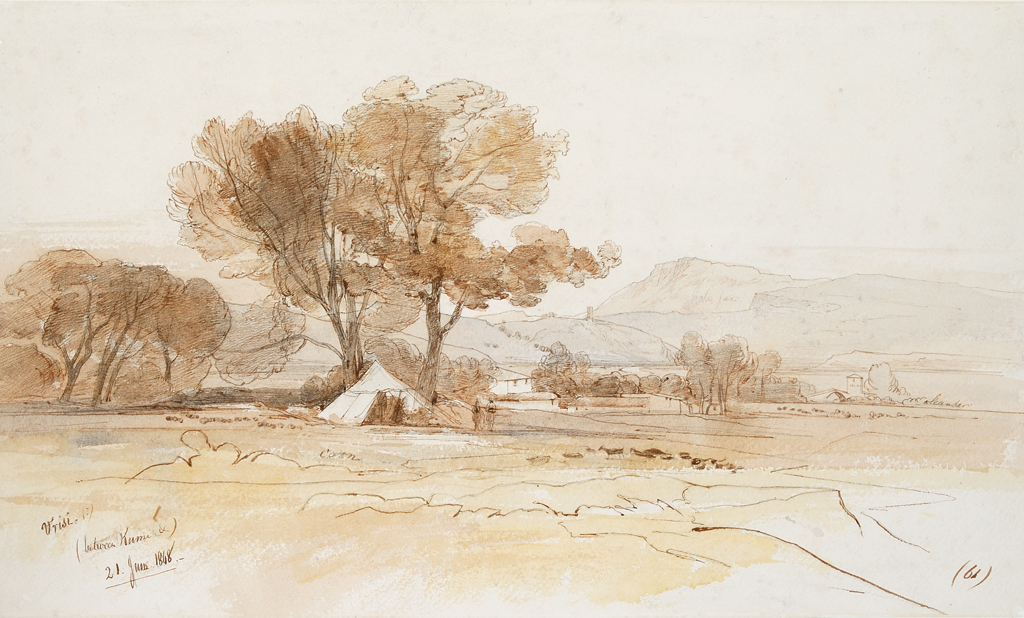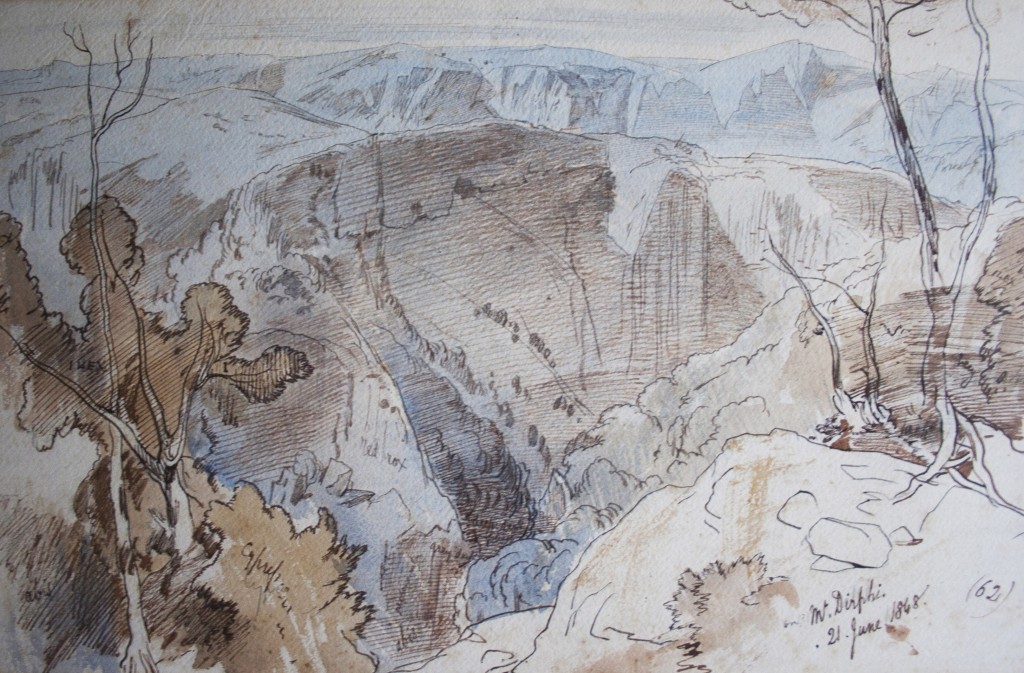Monday 19 June
CHALKIS
Rose at 3.30 a.m. and bathed with C.M.C. before sunrise, returning to breakfast. Wandered about alone from 6 to 11, drawing figures, etc. A fair, or bazaar, held just outside the walls of the fortified town — wondrous groups of people!! Short tunics, lined with wool, bordered with red or black, worked ditto on the women: families of blacks (or Negroes?);[27] altogether a scene of immense variety. Found a Greek friend of C. M. C. at the Inn, spoke only Greek. Their political bothering is potius aper — they talk of Escort being wanted North of Chalcis!
While Lear was sketching through Chalcis, my business meanwhile was to learn something of the state of the country in which our route was now to lie. Alarming letters had followed us from Athens: “The Government have received information that the insurgents[28] have reappeared in force upon the frontier and in Northern Greece. Take good advice at Chalcis when you are about to leave it for Thebes . . . .” As we had letters to some of the chief men of the place, the families of Boudouris and Ducas,[29] names of medieval history and of modern interest, there was no difficulty in obtaining advice, and the result was that we changed our route and, instead of going to Thebes and through the heart of the country to Delphi, we decided on making a week’s tour in Euboea, which was free from “insurgents,” was untrodden ground to travellers for the most part, and abounding, by all accounts, in beautiful mountain and woodland scenery, and we had letters to two English proprietors who had bought land in the island, since the war.
Lear had a wish to draw the sites of the two classic scenes which we had seen from a distance from the Attic side: Eretria, the old rival of Chalcis, the unhappy town on which the vengeance of the Persians had fallen before Marathon, and Cumi at the back of the island, the reputed founder of colonies bearing the same name on the Campanian shore of Italy and in Asia Minor.[30] From there we projected a week’s tour, crossing the lower slopes of Mount Dirphe to the wooded district of Achmet Aga, in the centre of the island, the Noel property, and to Castaniotissa at the North end, where our letters also lay to Mr Leeves, an English proprietor, and possibly to cross from thence to the parts opposite Lamia and Thermopylae and the frontier on the North.[31]
Our first day’s route from Chalcis was South, by Eretria to Aliveri, along the shore, under the mountain, and looking on the opposite Attic shore which we had left, through olive woods of Vassiliko, to Eretria at sunset — the sun in golden light upon houses, Acropolis, and mountain above, and upon sea and shore, where once was harbour, and the ships, which the Persians carried off. At Aliveri we entered the great plain to Cumi on the Eastern coast, and left the shores of the Euripus, with regret for loss of the daily sea baths we had enjoyed on either shore morning and mid-day. The sketch at Aliveri is marked by a vignette in the corner, which adds a humorous interest – a string of mules, laden with fir poles slung St Andrew’s cross wise, had shied at the white umbrella of the artist and much disturbed him in his sketch {sketch 53}. He has described the scene in which easel, umbrella and artist are toppled over with a legend of exclamation — “Ah! Croce di San Andrea!!
The next series of sketches, not less than twenty-five in number, during the next week, represent a great variety of Euboean scenery, mountain, and wood with distant views, and glen, and plain, comparatively unknown, and beautiful. Lear revelled in the scenes — “far finer than he had ever seen in the way of forest”, “finer than three times multiplied Dovedale and Derbyshire” — forest scenery, unusual in any other part of Greece, for Euboea had escaped the ravages of the Turks and Greeks in the late war, for the most part.
They illustrate the topography of the island, divided nearly in half by the great plain between the Northern and Southern blocks of mountain, Kandili and Dirphe in the North and centre, and the Karysto range on the South. This great plain is the waist of the long body of the island and stretching from Aliveri on the Western channel to Cumi on the Eastern Sea, and was the Lelantean plain, the most fertile granary of the island, which had in Venetian times a special officer to look after its irrigation and regulate the export of its harvests: “whose famous vineyards were in ancient days an object of unceasing strife between the rival cities of Chalcis and Eretria”.
Monday 19 June [continued]
We dined at noon (soup, fish, curry, roast fowl and pudding). After coffee and pipe, slept till 2, when old Janni packed up and packed us off in a hurry. Baggage badly loaded, and fell off close to the town. Thence we went by a beastly paved road, coasting the low shallow straits. Many springs of clear water running from below the harsh, bare, rocky hill on our left. (We passed an Aqueduct half a mile from Chalcis.) A long tract of very pretty ground, full of fine olives, succeeded, with Mt Dirphe always in view. Drew — the ground overspread with Acanthus, Clematis, etc. From 4 to 6 p.m. tiresome undulations of uninteresting low slopes near the sea — now and then a peep of the Oripo shore opposite. 6.30. a world of Lentisk, with garden paths. Just before sunset we got to the plain of Eretria, in time to secure the shadows of the mountain and Acropolis Hill — very fine and wild, and might make a good picture, with its deep-rooted Lentisk foreground, its gray rocky-path sides, its red road winding away, and its intense lilac distant hills. Janni went on before. While C. and I stayed to sketch, mules laden with long cross beams of wood nearly destroyed me, upsetting artist, sketching stool and all. {sketch 53} Little is left of the ancient Eretria, and the modern village is a queer dishevelled place of small square houses — like boxes or dominoes — many roofless and falling. We found things partly ready in one of these empty stalls — a strange land is this Greece! And after half an hour they gave us as good a tea as one could have in Grosvenor or Belgrave Square.
[27] There was a substantial Black population in Greece at this period, brought into the Ottoman Empire as slaves, often originally from the Sudan.
[28] Although the new Greek Constitution of 1844 had established a parliament and limited the powers of the King, sporadic uprisings continued, encouraged by the European revolutions of 1848. The area near Lamia was particularly unsettled.
[29] Vassilios Boudouris was a prominent Greek politician from Euboea, where his family owned magnesite and chromium mines. Descendants of the Doucas family, originally Byzantine nobility, still lived in Euboea.
[30] Ancient Cumi (modern Kymi) founded Cumae in Southern Italy and Cyme in Asia Minor.
[31] Before 1881 the Greek-Turkish border was only a short distance north of Lamia.




